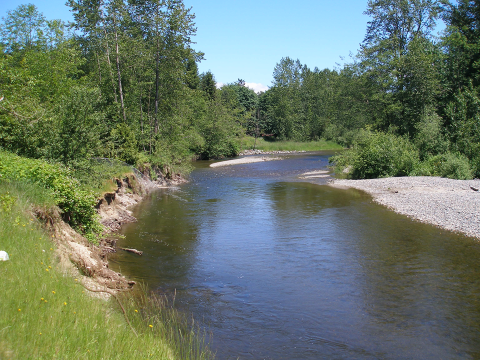The Pilchuck River and its tributaries need tree shade to keep their waters from getting too warm during the late summer and early fall, according to a Washington Department of Ecology report and plan.
Ecology seeks public comment on the document through Nov. 15, 2020, and will host an online community meeting about the study and plan at 5 p.m. on Oct. 29.
The draft water quality improvement plan for the Pilchuck watershed addresses the high temperatures and corresponding lack of dissolved oxygen in the river and its tributaries.
Cooler is better for salmon
Streams throughout the basin have lost the shade that once protected the water from the sun, primarily along developed reaches. Parts of the basin’s streams often reach temperatures above state standards in the summer and early fall and sometimes become warm enough to be nearly lethal for salmon and trout, including endangered Chinook salmon and steelhead trout.
Warmer water can lead to low dissolved oxygen in the river, meaning there is not enough oxygen for fish, insects and other aquatic animals to thrive.
Many public and private projects in the basin have begun to promote preservation and restoration of streamside vegetation and cool in-stream refuges. Tall trees provide the most effective shade, and fish benefit from occasional side pools when the main channel is too warm. The removal this past summer of a dam that formerly diverted water to the city of Snohomish will help support healthier summer flows and open 37 miles of habitat for migratory fish.
The draft Pilchuck watershed report contains an implementation plan that outlines strategies to cool the water and improve dissolved oxygen levels. These include:
-
Provide more shade and cold water refuges for fish. Area governments and organizations have mounted several ongoing tree planting and buffer projects, with more planned.
-
Increase water infiltration into the ground. Stormwater that soaks into the soil becomes cool groundwater, the major source of stream flow in the late summer and early fall.
-
Promote wise and efficient use of water. Reducing water withdrawals from streams and the ground promotes higher stream flows that can better resist hot conditions.
- Reduce nutrient pollution from stormwater runoff and wastewater treatment plant discharges. Nutrients feed biological processes that deplete dissolved oxygen in the water.
Information and comments
-
Visit Ecology’s website for more background information and links for viewing or downloading the study and plan.
-
Use Ecology’s online comment app to make coments about the study and plan. The app allows you to write online, paste text, or attach files.
-
Register in advance for the online community meeting. It’s recommended to sign in about 15 minutes early.
Technical questions should be directed to Heather Khan, Water Quality Specialist, Dept. of Ecology, 3190 160th Ave. SE, Bellevue, 98008-5452; 425-213-9832; or heather.khan@ecy.wa.gov.


